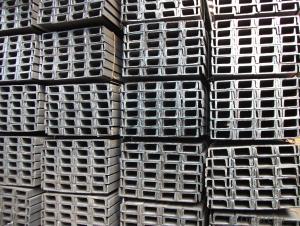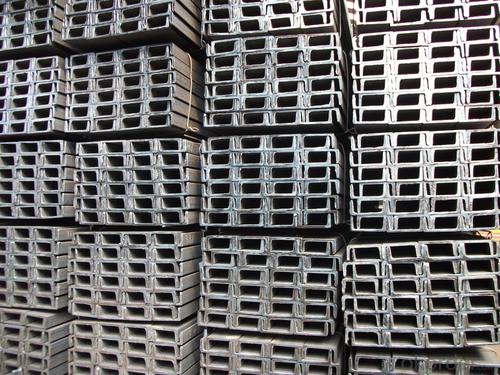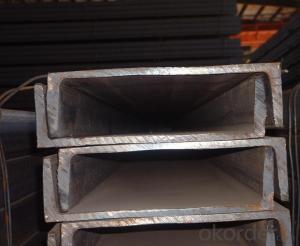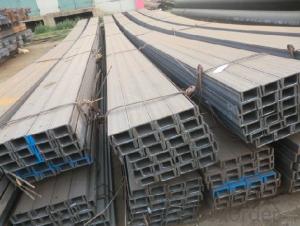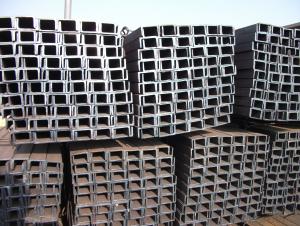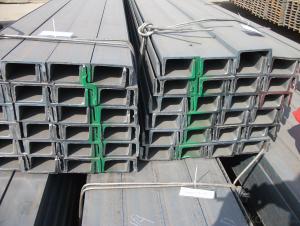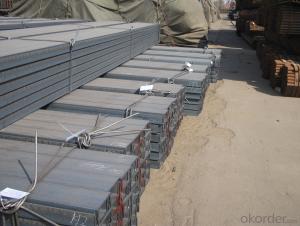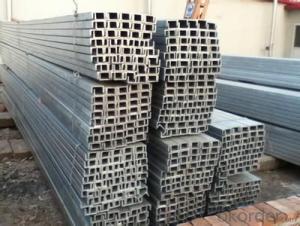Hot Rpled JIS Standard Steel U-channel SS400
- Loading Port:
- China Main Port
- Payment Terms:
- TT or LC
- Min Order Qty:
- -
- Supply Capability:
- -
OKorder Service Pledge
OKorder Financial Service
You Might Also Like
Product Description:
OKorder is offering STEEL CHANNEL at great prices with worldwide shipping. Our supplier is a world-class manufacturer of steel, with our products utilized the world over. OKorder annually supplies products to European, North American and Asian markets. We provide quotations within 24 hours of receiving an inquiry and guarantee competitive prices.
Product Applications:
1.The JIS channel can be devided into two kinds, namely common channel steel and light channel steel. The sizes of hot rolled common channel steel range from 5# to 40#. Meanwhile, the channel steel can be divided into cold forming sectional equal channel steel, cold forming sectional unequal channel steel, cold forming inner edge channel steel and outer edge channel steel.
2.The JIS channel is usually used for arch-itechtural structure, and they could be welded in order to support or hang a vari-ety of facilities. They are also usually used in combination with I beam. The channel steel with sizes under 14# is usually applied to construction engineering, as purline, while the channel steel with sizes above 16# is more likely to be used in building vehicle chassis structure and mechanical structure. Furthermore, the channel steel in sizes above 30# are target at building bridge structure, as tension bar.
3.In a word, the channel steel must possess perfect welding property, riveting property and mechanical property and so on.
Product Advantages:
OKorder's STEEL CHANNELare durable, strong, and resist corrosion.
Main Product Features:
· Premium quality
· Prompt delivery & seaworthy packing (30 days after receiving deposit)
· Corrosion resistance
· Can be recycled and reused
· Mill test certification
· Professional Service
· Competitive pricing
Product Specifications:
Minimum Order Quantity: 25 Tons Unit: m.t. Loading Port: Xingang Port
Supply Ability: 1000 Tons Per Day Payment Terms: TT or L/C
Product Description:
Specifications of Steel U Channel:
Standard Applied: GB Standard, EN Standard(UPN), JIS Standard
Sizes: 50mm to 300mm
Material Grade: Q235B, Q345B, S235JR, SS400, ASTM A36
Production Flow of JIS Channel:
1.The steel billet shall be heated in the high temperature furnace.
2. The heated steel billet shall be rolled five to nine times with the aim of shaping the general figure of steel u channel.
3. The rolled steel channel should be put onto the cooling bed to make the temperature low.
4. The JIS Channel should be straighted on the straightener.
5. The straighted steel u channel will be cut into meters by saw, as per customer's requirements.
6. At the last part of production, the channel steel must be tested in order to confirm that the finished products are completely free from crack, pore, slag, scab or fold on the surface.
Package & Delivery: Steel U Channel
The steel u channel will be packed in bundle with steel wire at each end of every bundle and color marking in order to help the customer to recognize his goods more easily at sight.
And steel u channel could be loaded into 20ft or 40ft container, or by bulk cargo. If the weight of each bundle reaches less than 3.5 mt, the loading by break bulk cargo should be choosed. When the weight of each bundle reaches less than 3mt, the loading by container should be choosed.
As for the transportaion from mill to loading port, the truck will be usually used. And the maximum quantity for each truck is 40mt.
All in all, we could do in accordance with customer's request
FAQ:
Q1: Why buy Materials & Equipment from OKorder.com?
A1: All products offered byOKorder.com are carefully selected from China's most reliable manufacturing enterprises. Through its ISO certifications, OKorder.com adheres to the highest standards and a commitment to supply chain safety and customer satisfaction.
Q2: How do we guarantee the quality of our products?
A2: We have established an advanced quality management system which conducts strict quality tests at every step, from raw materials to the final product. At the same time, we provide extensive follow-up service assurances as required.
Q3: How soon can we receive the product after purchase?
A3: Within three days of placing an order, we will begin production. The specific shipping date is dependent upon international and government factors, but is typically 7 to 10 workdays.
Grade | Yield Strength,N/mm² | Extension Strength N/mm² | |||
Thickness of Steel,mm | |||||
≦16 | >16-≦40 | >40-≦100 | >100 | ||
SS330 | ≧205 | ≧195 | ≧175 | ≧165 | 330-430 |
SS400 | ≧245 | ≧235 | ≧215 | ≧205 | 400-510 |
SS490 | ≧285 | ≧275 | ≧255 | ≧245 | 490-610 |
SS540 | ≧400 | ≧390 | - | - | ≧540 |
Grade | Element(%) | |||
C | Mn | P | S | |
SS330 | -- | -- | ≦0.050 | ≦0.050 |
SS400 | ||||
SS490 | ||||
SS540 | ≦0.30 | ≦1.60 | ≦0.040 | ≦0.040 |
Images:
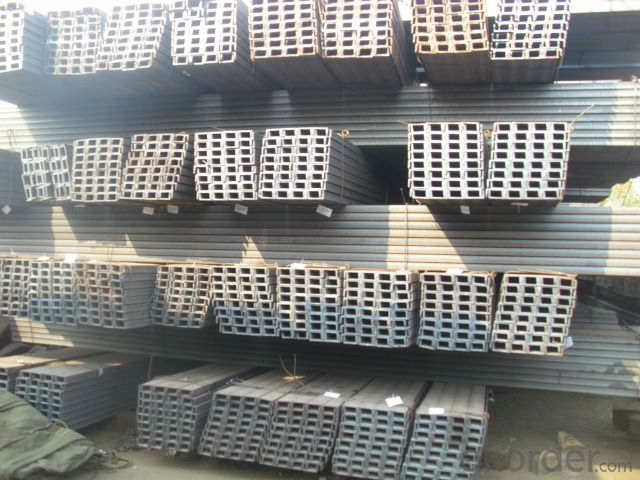
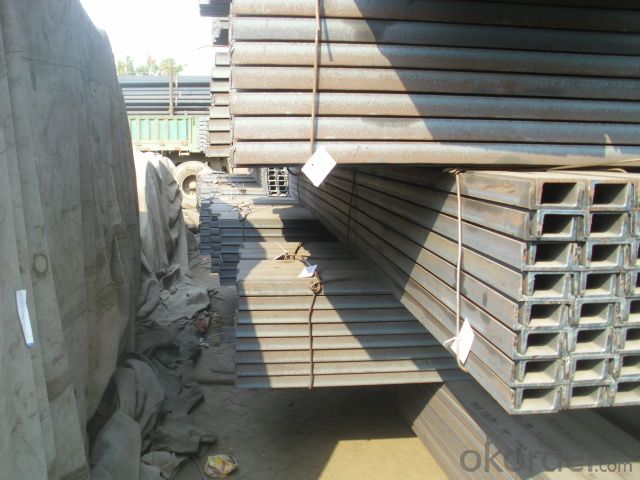
- Q: Are steel channels suitable for railway tracks?
- Steel channels are not suitable for railway tracks. Railway tracks require a specific type of steel rail that is designed to withstand the heavy loads and constant use of trains. Steel channels, on the other hand, are typically used in construction for structural support and do not have the necessary strength and durability to serve as railway tracks. Additionally, steel channels lack the necessary shape and design features, such as the proper rail profile and fastening system, required for safe and efficient railway operations. Therefore, it is essential to use dedicated steel rails specifically designed for railway tracks to ensure the safety and functionality of the railway system.
- Q: I encountered in the construction of 2 short 28# channel welding, processed into beams, how to weld? Do I have to have stiffened panels? How many pieces? What's the thickness of the stiffener? I heard that there is a book called "metal processing manual", which has instructions, but I do not have the book. Please give settlement.
- If the gap between the two weldment is not conducive to welding, it can be welded with a piece of steel plate. If the assembly gap is reasonable, direct rust removal and welding can be done.
- Q: How do steel channels perform in extreme weather conditions?
- Steel channels typically perform well in extreme weather conditions. Due to their strength and durability, they can withstand high winds, heavy rain, and even snow loads. Additionally, steel channels are resistant to corrosion, making them suitable for use in coastal areas or places with high humidity. Overall, their robustness and weather resistance make steel channels a reliable choice for various construction and infrastructure projects.
- Q: What are the different shapes available for steel channels?
- Steel channels, which are also referred to as C-channels or U-channels, are offered in various shapes to meet different needs and purposes. The most prevalent shapes for steel channels comprise: 1. Standard Channels: These are widely utilized and easily accessible steel channels. They possess a C-shaped cross-section with parallel flanges of equal size. Standard channels are commonly employed for structural purposes, such as supporting beams or framing. 2. Back-to-Back Channels: Also known as double channels or double C-channels, these steel channels consist of two standard channels placed back-to-back and joined by welding or bolting. Back-to-back channels offer enhanced strength and rigidity, making them suitable for heavy-duty applications like racking systems or conveyor frames. 3. Tapered Channels: Tapered steel channels have unequal flanges, with one flange wider or thicker than the other. These channels are designed to distribute weight and load more efficiently, making them useful in applications where weight reduction or specific load-bearing capabilities are required. 4. Hat Channels: Hat channels, alternatively referred to as C-purlins or Z-purlins, possess a distinct shape resembling the letters "H" or "Z". They are commonly employed in construction for roof and wall framing, as well as in the automotive industry for reinforcing vehicle structures. Hat channels offer excellent strength and stiffness while minimizing weight. 5. Custom Shapes: Apart from the aforementioned standard shapes, steel channels can also be custom designed and fabricated to meet specific requirements. Custom shapes may include curved channels, perforated channels, or channels with special cut-outs or patterns, depending on the intended application. It is crucial to note that the availability of different shapes may vary depending on the manufacturer and the specific steel channel product line. Therefore, it is advisable to consult with a steel supplier or manufacturer to determine the range of shapes available for steel channels.
- Q: What do you mean by "A" in the channel type?
- The same waist height, according to its thickness is divided into a, B, B, C or a.A thin waist is the most.The width of their legs is equal to the waist thickness difference, that is, the real leg (not including waist thickness) is the same length, and the average leg thickness is the same.
- Q: What is the weight per foot of various steel channel sizes?
- The weight per foot of various steel channel sizes can vary depending on the specific dimensions and thickness of the channel. In general, the weight per foot of steel channels can range from around 1.5 pounds per foot to over 20 pounds per foot. It's important to consult a steel channel weight chart or a manufacturer's specifications for precise weight per foot information for different steel channel sizes.
- Q: Are steel channels suitable for the mining manufacturing industry?
- Yes, steel channels are suitable for the mining manufacturing industry. Steel channels offer high strength and durability, making them ideal for withstanding heavy loads and harsh conditions commonly found in mining operations. Additionally, steel channels can be easily fabricated and customized to meet specific requirements, making them versatile for various applications in the mining manufacturing industry.
- Q: Can steel channels be used for window and door frames?
- Certainly! Window and door frames can indeed utilize steel channels. With their strength and durability, steel channels offer ideal structural support for windows and doors. They not only bolster the stability and long-lasting nature of the frames but also fortify them against external forces like wind and impact. Furthermore, steel channels possess the flexibility to be tailored and manufactured to fit specific window and door dimensions. This adaptability renders them an excellent option for diverse architectural designs and applications.
- Q: Can steel channels be used in agricultural applications?
- Yes, steel channels can be used in agricultural applications. Steel channels are versatile and durable structural components that can be utilized in various farm-related settings such as barn construction, equipment storage, fencing, and livestock handling facilities. They provide strength and stability, making them suitable for withstanding the demands of agricultural operations.
- Q: 10kV and below the distribution cabinet in the room, the basic channel should be higher than the indoor ground level? Which specification is clearly defined?
- The distribution cabinet is used in occasions where the load is more dispersed and the circuit is less. The motor control center is used in the situation where the load is concentrated and the circuit is more. They distribute the power of a circuit to the nearest load. This class of equipment provides protection, monitoring and control of loads.
Send your message to us
Hot Rpled JIS Standard Steel U-channel SS400
- Loading Port:
- China Main Port
- Payment Terms:
- TT or LC
- Min Order Qty:
- -
- Supply Capability:
- -
OKorder Service Pledge
OKorder Financial Service
Similar products
Hot products
Hot Searches
Related keywords
